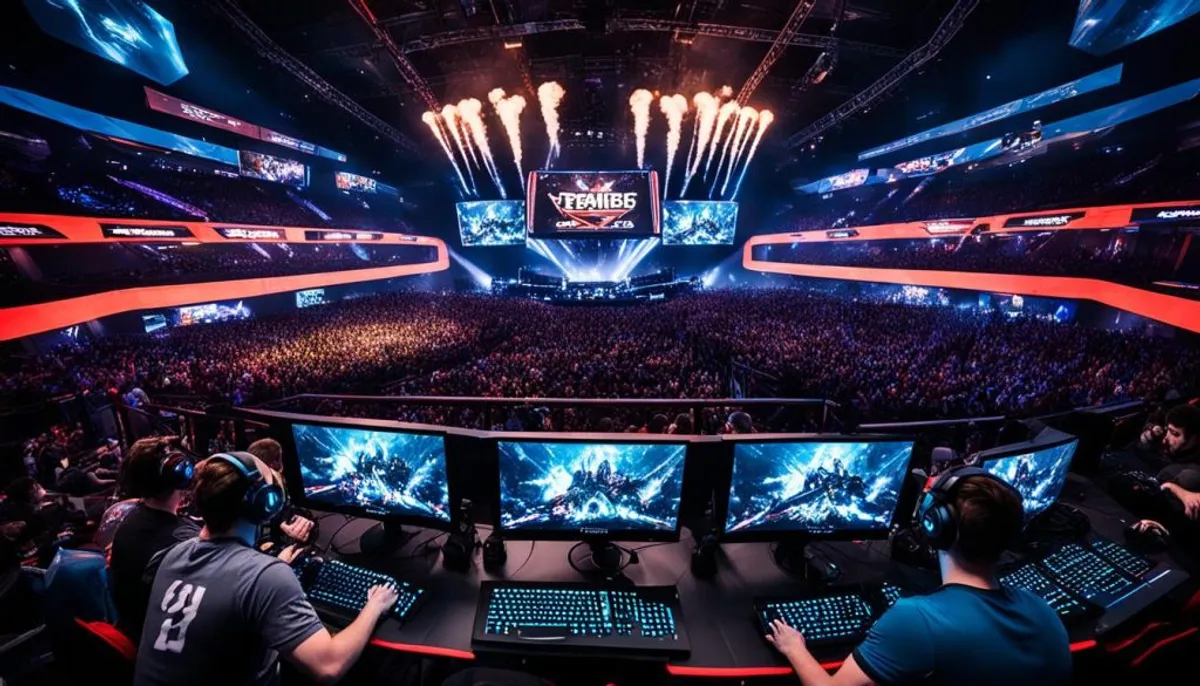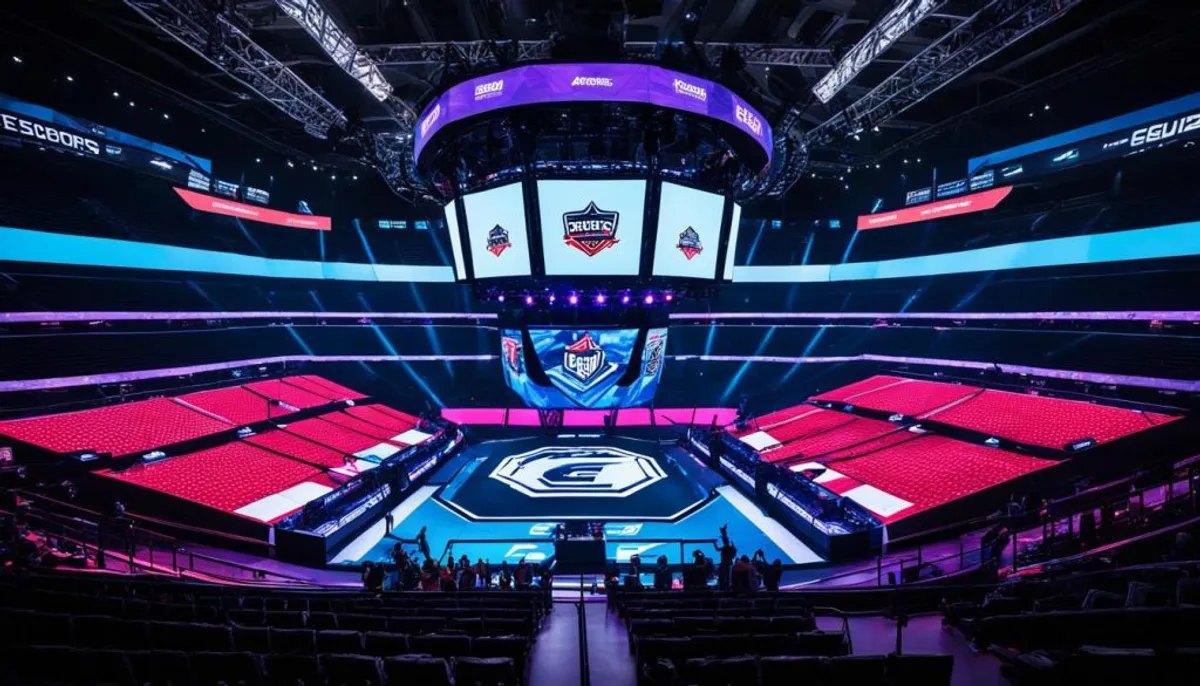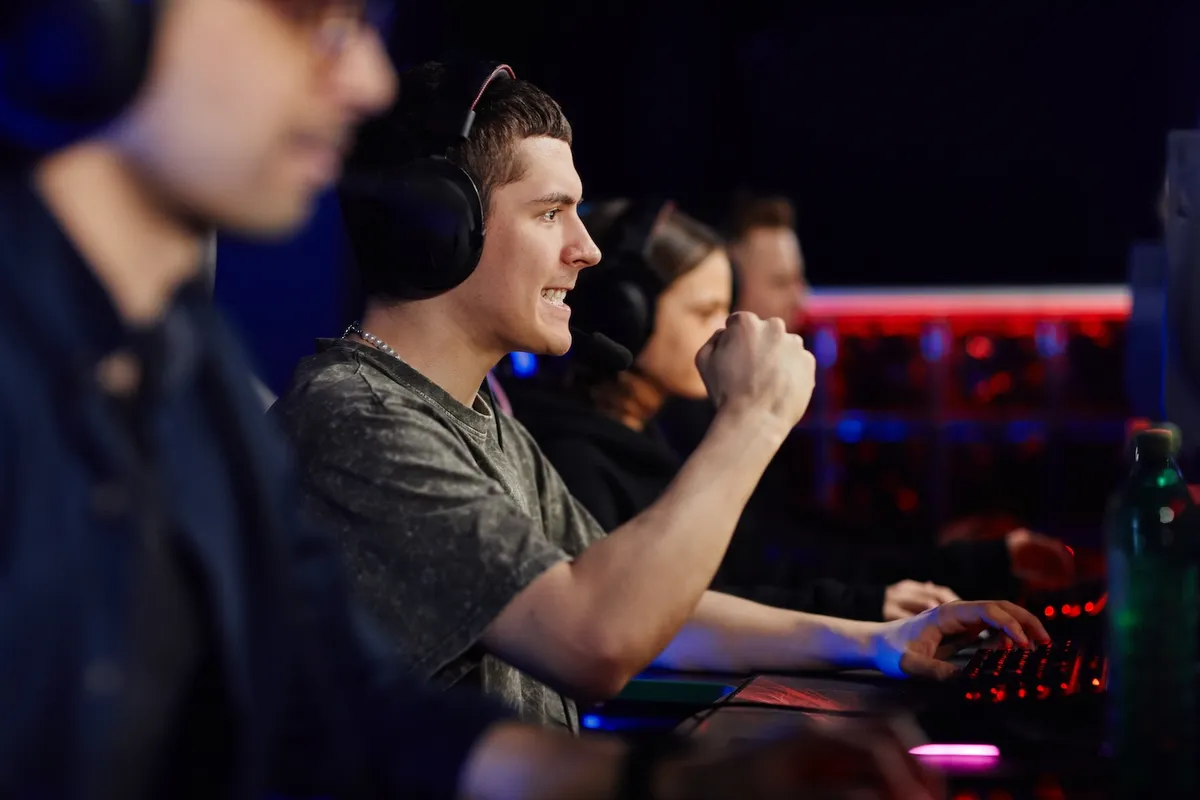Welcome to the thrilling world of esports! This digital arena has taken the world by storm. It has turned video gaming into a professional sport. Now, competitive gaming has grown from casual play to big tournaments with huge prizes.

Professional gamers are now stars, showing off their skills in games like League of Legends and Counter-Strike. They train hard, improving their speed and strategy for top-level play. Fans fill stadiums for these tournaments, cheering for their favorite teams and players.
The esports industry is now worth millions, thanks to passionate fans and big sponsors. Streaming sites like Twitch have helped it grow. They let fans watch and talk to their favorite gamers live.
Key Takeaways
- Esports has turned video gaming into a professional sport.
- Professional gamers are now seen as athletes and stars.
- Big video game tournaments draw millions of viewers worldwide.
- The esports industry is now a multi-million dollar market.
- Streaming sites have greatly helped esports grow.
- Competitive gaming covers many genres, from MOBAs to first-person shooters.
The Evolution of Esports: From Pong to Global Phenomenon
The history of esports is a thrilling story from its early days to a global phenomenon. It started with small gatherings and grew into huge gaming tournaments that attract millions worldwide.
Origins in the 1970s and 1980s
Esports started in the 1970s with home consoles. The first big event was in 1972 at Stanford University. Students played Spacewar, starting organized video game competitions.
In the 1980s, gaming tournaments grew fast. Atari’s Space Invaders Championship in 1980 had 10,000 players. This event showed the potential of competitive gaming and set the stage for esports.
The Rise of Multiplayer Games in the 1990s
The 1990s brought a new era with multiplayer games. Games like Street Fighter and Mortal Kombat led the competitive scene. Soon, first-person shooters joined, broadening esports.
“The 1990s were a pivotal time for esports. Multiplayer games changed everything, creating a foundation for the competitive gaming we know today.”
The Esports Boom of the 2000s
The 2000s saw a huge growth in esports. Big tournaments like World Cyber Games and Electronic Sports World Cup started. In 2011, Twitch changed the game by letting fans watch tournaments worldwide.
| Year | Milestone | Impact |
|---|---|---|
| 1972 | First Spacewar tournament | Birth of competitive gaming |
| 1980 | Space Invaders Championship | First large-scale gaming event |
| 1990s | Rise of fighting games | Expanded esports genres |
| 2000s | Major tournament organizers emerge | Professionalization of esports |
| 2011 | Twitch launch | Revolutionized esports broadcasting |
Understanding E-sport: Defining the Digital Athletic Arena
Esports, short for electronic sports, is the exciting world of competitive gaming. It has become a global phenomenon, turning video game competitions into a big event.
Esports is all about organized video game competitions. These events range from small local ones to huge international ones. They attract millions of viewers from all over the world.
Competitive gaming includes many game types, such as:
- First-person shooters (FPS)
- Multiplayer online battle arenas (MOBA)
- Fighting games
- Sports simulations
- Strategy games
Esports has become a big deal in the media, offering benefits to both pros and casual gamers. It helps improve skills like strategic thinking, problem-solving, and teamwork.
| Aspect | Traditional Sports | Esports |
|---|---|---|
| Physical Exertion | High | Low to Moderate |
| Mental Acuity | High | Very High |
| Accessibility | Varies | High (with internet) |
| Global Reach | Widespread | Extensive |
| Prize Pools | Large | Increasingly Large |
The esports industry is growing fast, changing entertainment, technology, and competition in the digital world. The future of competitive gaming looks promising, with new games, tournaments, and chances coming up all the time.
Popular Esports Games and Genres
The world of competitive gaming is huge and varied, filled with many top esports games across different genres. These games range from intense team battles to solo challenges. They attract millions of players and fans all over the globe.
Multiplayer Online Battle Arena (MOBA) Games
MOBA games are big in esports. Games like League of Legends and Dota 2 are huge hits at tournaments. They need strategic thinking, teamwork, and fast reflexes.
First-Person Shooter (FPS) Games
FPS games are key in competitive gaming. Games like Counter-Strike: Global Offensive, Valorant, and Overwatch are leaders. They test players’ aim, knowledge of the map, and tactical skills.
Fighting Games
The fighting game community is strong in esports. Games like Street Fighter, Mortal Kombat, and Super Smash Bros. show off amazing skills and precision. These games require quick reactions and deep knowledge of characters.
Sports Simulations
Virtual sports have found a place in esports. Games like FIFA, NBA 2K, and Rocket League bring sports excitement online. They mix real sports knowledge with gaming skills.
| Genre | Popular Games | Key Skills |
|---|---|---|
| MOBA | League of Legends, Dota 2 | Strategy, Teamwork |
| FPS | CS:GO, Valorant | Aim, Map Awareness |
| Fighting | Street Fighter, Smash Bros | Reactions, Character Knowledge |
| Sports Sim | FIFA, NBA 2K | Sports IQ, Controller Skills |
The Structure of Esports Competitions

Esports tournaments are similar to traditional sports in many ways. They range from local leagues to global championships. The structure usually includes group stages, playoffs, and grand finals.
Local tournaments help new players get noticed. They build community support and spot talented players. As players improve, they move to regional leagues, facing stronger opponents and learning more.
Top esports tournaments draw the best players globally. They offer big prizes and fierce competition. For example, the League of Legends World Championship sells out quickly.
- Group stages: Teams compete in round-robin matches
- Playoffs: Top performers advance to elimination rounds
- Grand finals: The ultimate showdown between the best teams
Some esports follow a league format, like traditional sports seasons. Teams play over months, earning points or wins for playoffs. This keeps fans engaged and players stable.
Esports has different tournament formats for everyone. Whether you’re a casual gamer or a hardcore fan, there’s a place for you in competitive gaming.
The Global Esports Ecosystem: Teams, Players, and Fans
The esports world is alive with professional gamers, teams, and a dedicated fan base. Together, they make up the heart of competitive gaming. This network is key to the industry’s growth and popularity around the globe.
Professional Esports Organizations
Gaming teams are central to esports. They manage teams in different games, offering salaries, training, and support. Famous teams like Team Liquid and Fnatic draw fans and sponsors.
The Life of a Pro Gamer
Professional gamers live intense lives focused on their skills. They often stay in team houses, following strict training to stay sharp. Their days are filled with:
- 8-10 hours of practice
- Team strategy meetings
- Physical exercise
- Mental conditioning
The Role of Esports Fans and Communities
Fans are crucial to esports. They support their teams by buying merchandise, going to events, and watching online. Online groups on Twitch and Reddit help fans connect and talk about the games.
| Fan Engagement Activity | Impact on Esports Industry |
|---|---|
| Watching live streams | Increases viewer numbers, attracting sponsors |
| Buying team merchandise | Provides direct revenue to organizations |
| Attending live events | Creates atmosphere, boosts ticket sales |
| Participating in online discussions | Builds community, drives content creation |
This mix of teams, players, and fans keeps esports growing fast. It’s becoming a big part of global entertainment.
Esports Broadcasting and Streaming Platforms
Since 2006, esports broadcasts have changed a lot. Game streaming platforms have changed how fans watch competitive gaming. Twitch, started in 2011, became the top choice for esports fans.

When Amazon bought Twitch in 2014, it made Twitch even more popular. YouTube Gaming also became a big name for esports fans.
Now, these platforms let fans watch their favorite players and teams live. This has made esports more popular worldwide. It has created a strong community and excitement among fans.
| Platform | Launch Year | Key Features | Popular Esports Games |
|---|---|---|---|
| Twitch | 2011 | Live chat, subscriber emotes, channel points | League of Legends, Dota 2, CS:GO |
| YouTube Gaming | 2015 | Video on demand, Super Chat, memberships | Fortnite, PUBG, Overwatch |
| Facebook Gaming | 2018 | Social integration, Level Up program | Mobile Legends, Free Fire |
These platforms have helped esports grow fast and become more popular. They connect players and fans directly, offering an experience that traditional sports can’t match.
The Economics of Esports: Prize Pools, Sponsorships, and Revenue Streams
The esports industry has seen a huge growth in recent years. It now has financial figures that match traditional sports. Let’s explore the main economic parts of competitive gaming.
Tournament Prize Pools
Esports tournament prizes have hit huge amounts. Events like The International for Dota 2 have prize pools over $30 million. These big rewards draw in top talent and make the competition fierce.
| Tournament | Game | Prize Pool |
|---|---|---|
| The International 2021 | Dota 2 | $40,018,195 |
| Fortnite World Cup 2019 | Fortnite | $30,000,000 |
| League of Legends Worlds 2021 | League of Legends | $2,225,000 |
Sponsorship Deals and Advertising
Gaming sponsorships are key to esports revenue. Brands team up with teams and players to reach young, tech-savvy fans. These deals cover jersey sponsorships, product placements, and creating exclusive content.
Merchandising and Ticket Sales
Esports makes money through merchandise sales. Fans buy team jerseys, hoodies, and more to show support. Big tournaments also make a lot from ticket sales, filling stadiums.
Esports has many ways to make money, from big prize pools to sponsorships. As it grows, so does its economic effect worldwide.
Esports and Traditional Sports: Convergence and Comparisons
The worlds of esports and traditional sports are coming together fast. This change is changing the sports industry and making us rethink what being an athlete means. As digital sports become more popular, the difference between playing games and real sports is getting smaller.

Esports athletes train just like traditional athletes. They work on quick reflexes, improve their hand-eye coordination, and get mentally strong. These skills are key in big tournaments where making fast decisions can win or lose the game.
When we compare esports and traditional sports, we find many similarities. Both need focus, strategy, and teamwork. The big difference is in the physical part. A basketball player needs to jump high, but an esports pro needs to click fast on a mouse.
“Esports is not just about playing games. It’s about strategy, teamwork, and mental strength. These are the same qualities we value in traditional sports.”
Traditional sports teams are now getting into esports. Many professional teams have esports teams because they see the big market and the growing number of fans. This mix is opening up new chances for athletes, fans, and businesses.
Even though esports is growing, it still has a hard time being seen as a “real” sport. But as the gap between esports and traditional sports gets smaller, it’s possible we’ll see esports in the Olympics next to sports like track and field.
The Impact of Technology on Esports Growth
Gaming technology has changed the esports world. It has brought us advanced hardware and software. These changes have made competitive gaming a global event. Let’s look at the main tech advances that are pushing esports forward.
High-Performance Gaming Equipment
Top esports athletes use the best gaming gear to win. They use powerful computers, fast monitors, and special peripherals. This equipment is key to esports, helping players react quickly and move precisely.
Internet Infrastructure and Streaming Technology
Good internet is key for online esports and global broadcasts. Fast connections and streaming platforms let millions watch esports live. This tech has made esports more accessible, connecting players and fans across the globe.
| Technology | Impact on Esports |
|---|---|
| 5G Networks | Reduced latency, improved mobile gaming |
| Cloud Gaming | Accessibility, cross-platform play |
| AI-powered analytics | Enhanced player performance, strategic insights |
Virtual Reality and Augmented Reality in Esports
VR and AR are changing esports. They offer immersive experiences for players and viewers. VR games like “Echo Arena” let players move in new ways in games. AR apps add game info and stats to live events for the audience.
“The fusion of VR and AR with esports is creating a new frontier in competitive gaming, blending physical and digital realms like never before.”
As these techs get better, they will change esports more. They will bring new games and ways for fans to watch.
Esports Education and Career Opportunities
The esports industry is booming, offering new paths for education and careers. Colleges and universities now offer esports scholarships, seeing competitive gaming as a real field of study. This change lets students who love gaming follow their dreams and get a degree.
Learning about esports is more than just playing games. Students study esports management, marketing, and event planning. These programs get graduates ready for many roles in the industry, like team management, broadcasting, and game development.
Gaming careers aren’t just for pro players. The esports world needs:
- Team managers
- Event organizers
- Broadcasters
- Marketing specialists
- Game developers
- Coaches and analysts
- Sports psychologists
This variety of roles mirrors traditional sports, offering a strong base for career growth in esports.
| Education Program | Career Path | Skills Developed |
|---|---|---|
| Esports Management | Team Manager | Leadership, Strategy, Finance |
| Game Design | Game Developer | Programming, Art, Storytelling |
| Esports Marketing | Brand Manager | Digital Marketing, Analytics, Sponsorship |
| Broadcast Production | Esports Commentator | Public Speaking, Game Knowledge, Live Production |
As the industry expands, so do the chances for esports scholarships and jobs. Universities work with gaming companies to offer top-notch programs. These programs give students practical training that’s relevant to the industry. This growing field promises a bright future for those who want to make a career out of their gaming passion.
The Physical and Mental Demands of Competitive Gaming
Competitive gaming is tough, both physically and mentally. Esports athletes need dedication, skill, and endurance. They face many challenges and use strategies to stay on top.
Training Regimens for Esports Athletes
Esports training is tough. Pro gamers practice for 8-12 hours a day. They work on their skills and quick reflexes. This can cause injuries and eye strain.
To avoid these problems, teams add physical exercise and proper ergonomics to their training.
Mental Health Considerations in Esports
Mental health in gaming is a big concern. The pressure to win and long hours can be hard on players. Now, managing stress is key in esports training.
Teams offer psychological support to help with anxiety, burnout, and pressure to perform.
The Importance of Work-Life Balance
Being healthy as a gamer is more than just training. A good work-life balance is key for success in esports. Many organizations focus on player development.
This includes:
- Regular breaks and downtime
- Proper nutrition and sleep habits
- Social activities outside of gaming
- Time management skills
This approach helps esports athletes keep up their careers and do well in competitive gaming.
“Balance is key in esports. We train hard, but we also make sure our players have time to recharge and live life outside of gaming.”
Challenges and Controversies in the Esports Industry
The esports world is not just about fun and games. It faces big challenges as it grows. Gaming addiction is a major concern, especially for young players who spend too much time on screens. This has led to talks about healthy gaming habits and the need for better player care.
Cheating in esports is another big issue. Some players use unfair tricks to win, making the game less exciting for others. This has sparked calls for stricter rules in esports. Game companies and tournament organizers are trying hard to catch cheaters and keep games fair.
Player welfare is also a big topic. Many pro gamers are young and new to the world of big contracts and sponsorships. There’s a growing effort to ensure these players are treated fairly and protected from being taken advantage of. The industry is also working to be more diverse and welcoming to players from all backgrounds.
Even with these challenges, the esports world is growing and getting better. It’s facing these issues head-on, making the future of competitive gaming look bright. With better rules and support, esports can become an even more exciting and fair place for gamers everywhere.
FAQ
What is esports?
Esports is short for electronic sports. It’s when gamers compete in video games with tournaments and leagues like real sports. Games like League of Legends and Fortnite are played by gamers alone or in teams.
How did esports evolve?
Esports started in 1972 with the first home consoles. The first esports event was in 1980 with Space Invaders. The 1990s saw the rise of popular games like Street Fighter.
The 2000s brought more growth, with big tournaments and the first TV esports event in 2006.
What are the popular esports game genres?
Esports games cover many genres. You’ll find Multiplayer Online Battle Arena (MOBA) games, First-Person Shooter (FPS) games, and fighting games. There are also sports simulations like Madden NFL.
How are esports competitions structured?
Esports competitions have different formats, like tournaments and leagues. They go from local to international, with group stages and playoffs. The grand finals are the highlight.
What is the esports ecosystem like?
The esports world has pro teams, players, and fans. Teams manage players, offer training, and support. Gamers often live together, training hard. Fans support teams by buying merchandise and watching online.
How is esports broadcasted?
Now, esports is broadcasted on platforms like Twitch and YouTube Gaming. These platforms let players connect with fans worldwide. This has made esports more popular and accessible.
What are the revenue streams in esports?
Esports makes money from tournament prizes, sponsorships, and ads. There’s also money from selling merchandise, donations, and event tickets.
How do esports and traditional sports compare?
Esports and traditional sports share some similarities, like the need for skill and teamwork. But, esports is still working to be seen as a “real” sport.
How has technology impacted esports growth?
Technology has helped esports grow. It includes better gaming gear, faster internet, and streaming tech. New tech like VR and AR is also changing the game.
What educational and career opportunities exist in esports?
Esports has created new jobs and courses in colleges. You can work in team management, event planning, or game making.
What are the physical and mental demands of competitive gaming?
Gamers train for long hours, which can hurt their bodies and eyes. They also face stress, burnout, and anxiety.
What challenges and controversies does the esports industry face?
Esports deals with issues like gaming addiction, cheating, and player welfare. There are also problems with diversity and inclusion.
RelatedRelated articles



